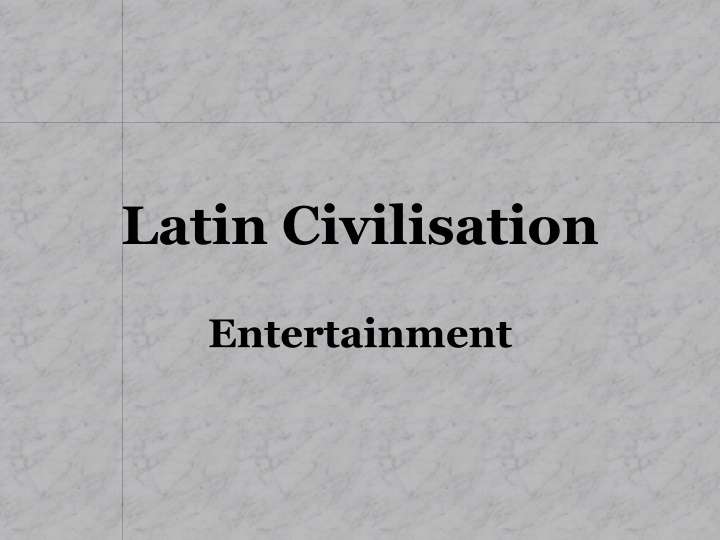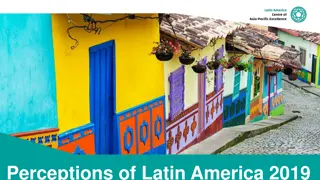
Roman Entertainment and Cultural Events
Discover the entertainment spectacle of ancient Roman civilization with a focus on panem et circenses (bread and circuses), ludi (public games), and munera (gladiatorial contests). Delve into the lavish investments in resources and the variety of entertainment forms enjoyed by the Roman populace, from grand public games to smaller street performances.
Download Presentation

Please find below an Image/Link to download the presentation.
The content on the website is provided AS IS for your information and personal use only. It may not be sold, licensed, or shared on other websites without obtaining consent from the author. If you encounter any issues during the download, it is possible that the publisher has removed the file from their server.
You are allowed to download the files provided on this website for personal or commercial use, subject to the condition that they are used lawfully. All files are the property of their respective owners.
The content on the website is provided AS IS for your information and personal use only. It may not be sold, licensed, or shared on other websites without obtaining consent from the author.
E N D
Presentation Transcript
Latin Civilisation Entertainment
Panem et circenses (bread and circuses) This phrase by Juvenal, a second-century CE satirist, means that the Roman people had conferred consulships commands in their political assemblies during the Republic emperors, desired only panem et circenses. His opinion has become current and military but, under the
Panem et circenses (bread and circuses) His opinion has become current and has led modern scholars to think that Romans preferred spectacle (the simple amusement of passive onlookers, which was meant to entertain) over theatre (i.e. an undertaking meant to motivate a the audience to higher ideals)
Panem et circenses (bread and circuses) However, it is clear that in Rome there was a great investment in resources time, money, energy for such popular entertainment. Even today, the towering remains of Roman entertainment buildings stand as concrete testimony to the importance of what went on inside them: amusement, perhaps, but not simple pleasure.
Ludi et Munera Ludi = public games in the circus or theatrical shows, offered by the state as civic celebrations. Munera gladiatorial contests especially. = private productions, featuring There were also smaller, localized forms of entertainment as well, such as jugglers, magicians, musicians, and poets, but evidence for this sort of street performance is slim to none.
Ludi Games were held annually in honour of different gods and could last for several days. Seven principal ludi marked the Roman calendar: Ludi Megalenses (in honour of Mater Magna): 4-9 April Ludi Cereales (in honour of Ceres): 12-18 April Ludi Florales (in honour of Flora): 27 April-3 May Ludi Apollinares (in honour of Apollo): 6-12 July Ludi Romani (in honour of Jupiter): 4-12 September Ludi Victoriae (in honour of Victory): 26-31 October Ludi Plebeii (in honour of Jupiter): 4-12 November
Ludi Other occasions for games: - a military victory - the death of an emperor
Ludi Organisers: the aediles Two parts: dramatic performances (ludi scaenici, from scaena, the Latin term for a stage- building) chariot races (ludi circenses) in the Circus Maximus
Places for the Ludi Early Republic: there was no permanent theatre built to accommodate the ludi scaenici of the various festivals. All stage performances were structures built specifically for the ludi and taken down after the celebrations. held in wooden
Places for the Ludi 55 BCE: Pompey the Great erected a massive theatre. Reign of Augustus: Theatres of Marcellus and of Balbus. All these were located in the Campus Martius, just outside the city proper but immediately accessible from it. Apparently the Senate had stopped earlier attempts to build a permanent building because it feared the idle masses lingering in the theatres all day.
Origins of Roman drama The Roman drama staged in the wooden theatres probably had unscripted farces found in other Italian cities. These performances are called Atellanae fabulae, named after the Campanian town of Atella, and used stock characters in comic situations improvised from everyday life: the Pappus (the old man), the Bucco (the fool), and the Dossennus (the glutton). It is likely that early ludi scaenici included such popular forms of entertainment. its roots in the
Ludi: Origins of Roman drama Then the influence of Greek drama started, due to the Roman expansion throughout the Italian peninsula and the Mediterranean. In imitation of Greek drama, scripted plays based on its genres (in particular comedy and tragedy) were introduced by the late third century BCE.
Ludi: Origins of Roman drama Other theatrical forms related to the Greeks: mime and pantomime. Mime Mime artists are known to have performed during the Republic, perhaps initially as improvised street theatre. Like the Atellan farces, the topic of mime tended to be comic stock situations drawn from ordinary life (perhaps akin to modern-day soap operas, with themes such as adultery or the trickster), although these tended to be better prepared and rehearsed than the Atellanae. Mime artists included both men and women who were organized into troupes under the leadership of an archimimus ( mime leader ). Due to its popularity during the Republic, mime became one of the important forms of entertainment at the Floralia.
Athletic competitions (agones) There is evidence for competitions from the early Republic. The Etruscan king Tarquinius Priscus (VII cent. BCE) first celebrated the Ludi Romani, which included equestrian events and boxers imported from Etruria. In 186 BCE the first proper athletic contest (athletarum certamen) took place at games organized by Marcus Fulvius Nobilior in honour of Jupiter Optimus Maximus. It was a contest on the Greek model, probably with Greek athletes imported or invited for the purpose.
Athletic competitions (agones) The Romans attitude to athletics is different form the Greeks . For the Greeks, participation in the gymnasium and the world of athletics was a sign of elevated social status. Unlike them, the Romans saw athletes as mere performers disdained public performance, disregard their importance. Furthermore, although Roman culture celebrated martial excellence and recognized the importance of physical fitness in military training, the Romans found very little in athletic training that was valuable in this respect. and, they since tended they to
Ludi: Athletic competitions (agones) Chariot races Chariot teams were arranged into factions identified by colour: red, white, blue, and green. A chariot team usually included 4 horses (a quadriga), although as many as 10 horses are attested. The presiding magistrate (typically a praetor) indicated the start of the race by dropping a cloth, the mappa. The teams then raced from the starting gates down the track to complete seven laps around the central barrier, which was about two- thirds the length of the track. The hairpin turns at the posts (metae) were the most dangerous parts of the course and could be the cause of spectacular crashes, which the Romans came to refer to as shipwrecks (naufragia). The race concluded on the slopes of the Palatine Hill, where Augustus located the imperial box (pulvinar).
Ludi: Dramatic competitions (agones) Emperor Nero introduced the Neronia in 60 CE. It was a festival with competitive dramatic performances and was intended to be held on a four-year basis in imitation of the great games of the Greek world (Olympian, Nemean, Isthmian). It included dramatic competitions. Pythian, musical and and
Ludi: Dramatic competitions (agones) The Neronia did not survive Nero reign. However, in 86 CE the emperor Domitian established the Capitolia, a Greek-style agonistic competition in honour of Jupiter Capitolius (in the same way that the Olympian Games were in honour of Zeus Olympius). These games proved to be more enduring and included musical, athletic, and equestrian competitions. For his games, Domitian constructed a large Greek-style stadium in the Campus Martius, where Piazza Navona is today. Besides Rome, other cities in the western empire, such as Carthage, established Greek-style sacred agones with athletic programs. It should also be noted that athletic competitions in the Greek, eastern half of the empire flourished during the imperial period as many emperors, encouraged them and offered imperial patronage. especially Hadrian,
Munera These gladiatorial combats and were associated with funerary spectacles. recorded gladiatorial combat took place at the funeral of Decimus Iunius Brutus Pera in 264 BCE. In the imperial period that these events were detached from the funerary context and offered as regularly occurring spectacles. private shows mostly involved The first
Places for Munera The oldest stone amphitheatre was built in Pompeii (70 BCE). In the early imperial amphitheatre was constructed in Rome. The form of the permanent stone amphitheatres reflects their long evolution as provisional wooden structures. The Colosseum, the largest amphitheatre in the empire, was erected during the reign of Vespasian (80 CE) on the site of Nero s Domus Aurea ( Golden Mansion ). Where Nero had constructed an enormous palace for his own use, allegedly burning the houses of the poor to make room for his project, the new emperor erected a structure for the benefit of the people of Rome. period a permanent
Program of the Munera Morning: displays and hunts (venationes) of wild beasts Evening: executions of convicted criminals (damnati) and gladiatorial combats
Program of the Munera: venationes The ambitious magistrates charged with organizing the ludi, could add these spectacles, founded privately, and so win popularity for themselves. Animals were not simply put on display but were matched against each other or hunted and killed by professional hunters, sometimes by the thousands. In one victory celebration lasting 123 days, the emperor Trajan boasted that 10,000 gladiators fought and 11,000 animals were killed. Those numbers work out to an average of almost 90 animals killed per day.
Ideology of the Munera: venationes The Romans had a different sensibility from us on the treatment of animals. To them, the dangerous wild animals in the natural world were an enemy of civilization and it was right to kill them: What would life be if lions and bears ruled, if power over us were given to snakes and all the other dangerous animals? Those creatures lack reason and have been condemned to death by us on the charge of their brutality , says Seneca. The public slaughter of exotic wild animals indicated the triumph of (Roman) civilization over the dangerous natural world.
Program of the Munera: executions The convicts were made to dress as mythological figures and re- enact their death (a phenomenon that modern scholars have termed fatal charades ). Otherwise, they were brought out to be devoured by wild beasts (damnatio ad bestias). The desire to display executions publicly may seem to indicate a level of cruelty, but we should remember that it was also typical in modern Western culture. Those being executed had been convicted and sentenced to death in the arena. In the eyes of the Roman authorities and Roman people, those being executed were the enemies of Roman society. Just as the arena was the place where dangerous natural enemies were killed, so too was it the place where the human enemies of Roman society were visibly eliminated.
Ideology of the Munera: executions The arena was the place where civilisation confronted nature, in the shape of beasts which represented a danger to humanity; and where social justice confronted wrongdoing, in the shape of the criminals who were to be executed there; and where the Roman empire confronted its enemies, in the persons of the captured prisoners of war who were killed or were forced to kill one another in the arena. Thomas Wiedermann
Program of the Munera: gladiators Gladiators were slaves who had been sold into service under the lanista (an owner/manager of a familia gladiatoria, a troupe of gladiators). They were well-trained professional fighters and fell into a number of distinct types. We have epigraphical evidence of a doctor secutorum (a trainer of secutores) and a doctor retiariorum (a trainer of retiarii), suggesting that the different types of gladiators employed different tactics.
Program of the Munera: gladiators Within each type, the gladiators also seem to have been ranked, with the recruit (tiro) at the bottom. A tiro was not a raw novice but an extensively trained professional gladiator of particular type who had not yet fought in public. Ranking gladiators would have helped in establishing the relative costs of gladiators when an official and lanista arranged for the lease of gladiators for a show: the better the gladiator, the more he would have cost.
Program of the Munera: gladiators Popular imagination often supposes that the gladiatorial combats were little more than spectacles of death and that the participants were either especially desperate men or homicidal maniacs, the sources suggest otherwise.
Program of the Munera: gladiators 1) In the vast majority of cases, a gladiator could submit if he were wounded in a fight. 2) Contests were governed by a series of rules and expected behaviour that gladiators generally followed (the lex pugnandi). 3) Fights to the death Gladiators were expensive and wasting them on a single fight would have been stupid. were exceptional.
Program of the Munera: gladiators If wounded or exhausted in the fight and nearing defeat, a gladiator could submit to his opponent by lowering his shield and weapon and raising a finger. At this stage, his opponent could easily wound or kill him, but this move was extremely rare. Gladiators fought for victory but not necessarily to wound or kill their opponents. An official, who was present in the arena with the fighting gladiators, stepped in to separate the two.






















